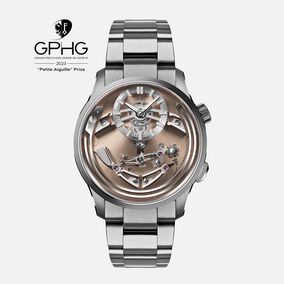While auto-assembly is often a feature of watchmaking, the complexity of the Bel Canto painstaking means assembly by hand is the only option
Here’s a bit of inside knowledge that’s rarely talked about outside of Switzerland’s hundreds of watchmaking ateliers, big and small, and it all revolves around how the various parts of the movement are actually put together. Generally, this happens in two steps, known as T0 and T1. In T0, various sub-assemblies are created; then, in T1, they’re all put together to create the completed movement. Think, perhaps, of building a model aeroplane kit: you take the pilot, add his arms and helmet, stick him to a seat, mount the seat to the cockpit floor, and attach the instruments, yoke, side stick, centre stick and so on until the cockpit’s complete: that’s T0. Then, when you actually attach the cockpit to the fuselage, that’s T1.

Of course, in watchmaking it’s slightly more complicated than that, and particularly with a piece like the Bel Canto. With the majority of watch movements, such as those you might find in a Trident or Sealander, the sub-assembly – or T0 – process can be automated to a great extent. At Christopher Ward, for example, we have a servo press, made by a company called AxNum AG, which can move in three axes – the x-axis, y-axis and z-axis – and uses a vacuum to pick up parts. Crucial watch movement components, such as bearing jewels, pins and bushings, can be put in the right place by this machine, then pressed to the correct height. (Indeed, the accuracy in the z-axis is an amazing +/-0.001mm.)
But with more unusual – and aesthetically demanding – movements, such as FS01 in the Bel Canto, automated assembly would only get you so far. For instance, it would be possible to automatically load the Bel Canto’s delicate platine with components – but from the top side only. Using a machine to similarly assemble the underside would be to risk disaster, as to do this the platine would have to be held in place by clamps attached directly to the top surface’s gorgeous, delicate sunburst finish, doubtless leaving unsightly (and unacceptable) marks.

Similarly, the geometry of the individual bridges needed to hold such elements as the hammer and on/off pointer (the bird’s beak) is so complex that machines are best left out of this process entirely. It’s why so much of the Bel Canto is assembled the old-fashioned way, entirely by hand.
This said, the pre-assembly of the various bridges and plates is relatively simple – when compared to the hoops we have to jump through when putting together another crucial Bel Canto sub-assembly, the clamping lever. This inconspicuous little component not only has to perform several tasks at the same time, but requires building from no fewer than nine individual parts.
In fact, the clamping lever is one of the hardest working watch parts you’ll ever meet. In the centre, it senses the worm on the minute drive, which is responsible for the hourly release (and so the Bel Canto’s musical sound). It also contains a mechanism that allows it to always return to its original position when the hands are turned back, without blocking the movement. It’s either released by the ratchet wheel, or blocked when the gong mechanism is turned off.

And, finally, it pre-tensions the hammer in the course of each hour, so that it has enough travel to strike the mainspring vigorously on the hour.
With all watches – but especially the Bel Canto, where perfect finishing and pristine surfaces are paramount – the biggest challenges at both the T0 and T1 stages involve keeping everything perfect, and, in particular, avoiding scratches or other marks on components from the different tools required to screw it all together. Steel parts, such as screws and pins, are usually positioned with brass tweezers, as brass is softer than steel; similarly, softer components – such as brass bridges – demand we use specialist tweezers with wooden tips.

Lastly, after pre-assembly has taken place, all the parts are cleaned and epilamised – a process in which the assemblies are dipped into a solution, leaving behind a wafer-thin, wax-like layer after drying. The resulting reduced surface tension prevents the lubricants from flowing off during T1, keeping each component dry and clean around the lubricated points.
That’s T0 and T1, then: the stages where all the various sub-assemblies are put together to create a complete module, adjusted, lubricated, and then united with the basic movement.
Not surprisingly, all this takes quite some time. No less than 90 minutes per movement, in fact, when the entire process is taken into account.
For more behind the scenes stories from Christopher Ward, visit christopherward.com/loupe
Related watches

Sign up to Loupe magazine
Loupe is Christopher Ward’s quarterly in-house magazine. If you want to know what’s happening at CW (and you love great journalism), this is where to start. Alternatively, you can read all our back issues on your computer, tablet or phone.
Order your free copyRead Loupe online





